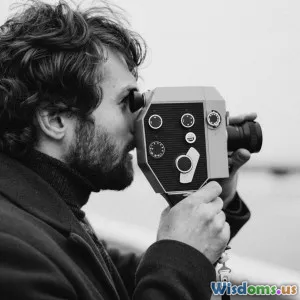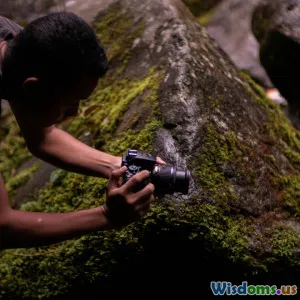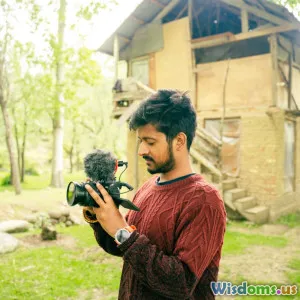
Tips for Successful Documentary Projects
8 min read Master the art of documentary filmmaking with actionable tips to ensure your project’s success from concept to screen. (0 Reviews)
Tips for Successful Documentary Projects
Documentary filmmaking is a powerful medium that captures reality, informs audiences, and can influence social change. Unlike fictional films, documentaries demand a unique blend of storytelling, investigative rigor, and creative vision to bring authentic stories to life. Yet, success in this field often remains elusive for many emerging filmmakers due to the complex nature of handling facts, emotions, and technical constraints simultaneously.
Whether you are an aspiring documentarian or a seasoned filmmaker looking to hone your craft, understanding the nuances that can elevate your project makes all the difference. This deep dive explores crucial tips that not only enhance your production’s quality but also maximize its impact and reach.
1. Start with a Compelling Concept and In-Depth Research
The foundation of any successful documentary is a strong, clear concept anchored in thorough research.
-
Niche Selection: Focus on stories that genuinely ignite your passion and offer a fresh perspective. Ken Burns, renowned for historical documentaries, advises choosing topics you personally connect with, as this enthusiasm infuses authenticity.
-
Preliminary Research: Dive deep into your subject to understand all angles. This includes reading articles, books, interviewing experts informally, and initial location scouting.
-
Nailing the ‘‘Why’’: Ask yourself what makes your story worth telling. Are you uncovering an untold truth, spotlighting an injustice, or capturing a cultural phenomenon with nuance?
Example: The documentary Searching for Sugar Man succeeded partly because the filmmakers uncovered the surprising story of musician Sixto Rodriguez and his unforeseen legacy – something almost no one else knew.
2. Plan Meticulously but Remain Flexible
A documentary’s organic nature necessitates a delicate balance between careful planning and adaptability.
-
Treatment and Story Outline: Draft a treatment that outlines the narrative arc, main characters, and potential scenes. This helps secure funding and clarify objectives.
-
Budget & Schedule: Allocate resources wisely, understanding that documentaries often encounter unforeseen delays. For instance, The Cove involved clandestine filming requiring intense security and flexible timelines.
-
Gather a Dedicated Team: Successful projects hinge on crew members who believe in the story. Documentary crews tend to be smaller, so versatility is key.
Yet, real life rarely abides by plans. An ability to pivot when stories evolve is essential.
3. Master the Art of Storytelling
Storytelling in documentaries differs from fiction — it requires structuring real-world events into engaging narratives.
-
Character Development: Highlight relatable human elements. Let audiences connect emotionally through authentic voices.
-
Conflict and Stakes: A compelling documentary needs clear tension or stakes, whether social, political, or personal.
-
Narrative Structure: Techniques such as the three-act structure or thematic chapters help maintain momentum. Werner Herzog’s films are often marked by poetic narration that bridges facts and emotion.
-
Use of Interviews: Pose open-ended questions to allow subjects to reveal themselves naturally. This results in more genuine, multifaceted perspectives.
Data Insight: According to the International Documentary Association, viewers prioritize emotional resonance and storytelling clarity over pure information.
4. Prioritize Cinematography and Sound Design
The raw impact of a documentary often lies in how it looks and sounds, balancing authenticity and aesthetic appeal.
-
Visual Storytelling: Cinematic techniques like varied camera angles, natural lighting, and capturing candid moments elevate the film’s quality. Films such as Honeyland showcase how striking visuals create empathy and immersion.
-
Soundscapes and Music: Clear, crisp audio is critical — noisy environments or poor recording can disengage viewers. Thoughtful use of ambient sounds or score sets tone without overwhelming narrative.
-
Equipment Choice: Portable, high-quality cameras (e.g., Sony FX3, Canon EOS R series) and professional microphones help capture compelling footage and sound, especially for documentaries with unpredictable environments.
5. Ethical Considerations and Authenticity
Maintaining ethical integrity is central to documentary filmmaking; it affects credibility and the relationship with subjects.
-
Informed Consent: Always obtain permission from participants, explaining how their footage will be used.
-
Balanced Representation: Avoid manipulation or selective editing that distorts truth. Nora Alter, director of We Are: The Brooklyn Saints, highlights transparency as a cornerstone of trust.
-
Navigating Sensitive Topics: Approach delicate subjects with respect and cultural awareness, potentially consulting local experts.
6. Post-Production: Weaving the Narrative
Editing transforms raw footage into a cohesive story.
-
Story Re-evaluation: Sometimes the story you envisioned initially might shift during editing. Be open to restructuring for clarity and impact.
-
Pacing and Rhythm: Use pacing strategically—slower moments for reflection, faster cuts to build tension.
-
Color Correction and Sound Mixing: Ensure visual consistency and clear audio balance.
7. Distribution and Audience Engagement
A well-crafted documentary deserves an audience.
-
Film Festivals: Submit to renowned festivals like Sundance or IDFA to gain credibility and exposure.
-
Streaming Platforms: Services such as Netflix, Hulu, and dedicated documentary platforms expand viewership globally.
-
Community Screenings and Educational Outreach: Engage local groups or institutions, particularly if your documentary has social impact.
-
Marketing: Use trailers, social media campaigns, and press kits effectively.
Case Study: Ava DuVernay’s 13th gained immense visibility with Netflix distribution combined with coordinated academic discussions.
Conclusion
The journey of crafting a successful documentary project is both an artistic challenge and a demanding endeavor involving meticulous research, ethical storytelling, technical prowess, and thoughtful distribution strategies.
Approaching these projects with passion, flexibility, and an unwavering commitment to truth not only enriches your film but honors the subjects and audiences you serve. Whether you aim to expose societal issues, celebrate extraordinary lives, or chronicle unseen histories, these tips illuminate a path toward documentary filmmaking that resonates and endures.
“Documentaries open windows to the world,” states acclaimed filmmaker Errol Morris. Your role is to ensure those windows are clear, compelling, and worthwhile to gaze through.
Embark on your next documentary with these principles, and watch your storytelling ripple across screens and hearts worldwide.
Rate the Post
User Reviews
Popular Posts




















